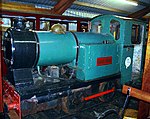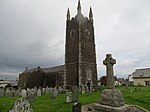Bucks Mills

Bucks Mills is a small village within the parish of Woolfardisworthy on the north coast of Devon, England. It was anciently the mill of the manor of Bucks, anciently Bokish, Buckish, Bochewis, etc., listed in the Domesday Book of 1086 as Bochewis. The village is within the North Devon Coast Area of Outstanding Natural Beauty and on the South West Coast Path. Next to the village is Bucks Woods which includes the site of the Iron Age Hill fort at Peppercombe Castle. The stream which runs through the village powered at least one mill. It falls over the cliff edge in a waterfall onto the beach which has large pebbles and hard sandstone formations. In the Elizabethan era a break in the rocks, known as the Gut, was created by Richard Cole (1568-1614), lord of the manor of Bucks, by blasting the rock with gunpowder to allow access to the small harbour built by him, which has since disappeared, creating a small harbour for fishing vessels. In the 18th century this was used for the import of culm, a mixture of anthracite and limestone which was burnt in kilns to produce fertiliser. The remains of two of the lime kilns can be seen on either side of the beach access.In the 18th and 19th centuries many of the residents of Bucks Mills and the surrounding villages were related to the Braund family and King Cottage within Bucks Mills was once the home of Captain James Braund who was informally known as the "King of Bucks".St Anne's church was built in 1862. The church was endowed by Mrs. Elwes, the Lord of the Manor of Walland Cary, the estate on which the village stood.At Bucks Mill Cabin resided artist Mary Stella Edwards and Judith Ackland.
Excerpt from the Wikipedia article Bucks Mills (License: CC BY-SA 3.0, Authors, Images).Geographical coordinates (GPS)
| Latitude | Longitude |
|---|---|
| N 50.9863 ° | E -4.3418 ° |







